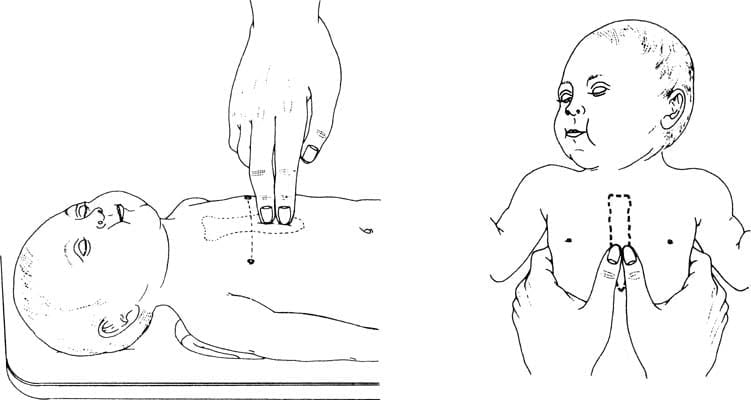Chest compressions form the basis of BLS in both adults and children.
Please review adult compressions lesson before proceeding to this. Click here to review.
If you don’t have a pocket mask or if you are not comfortable giving mouth to mouth ventilations, you may proceed with compression only CPR. Meaning, compressions should be a priority in CPR and minimizing interruptions is a quality indicator.
The ratio of compressions to breaths is 30:2 in pediatric and adult population when there is a single rescuer. When there are more than one rescuer, you must switch to 15:2 ratio (2 breaths every 15 compressions), giving more ventilations in children as most of the cardiac arrests in children are due to problems with oxygenation, rather than heart related issues.
Child – From 1yr, till the age of puberty.
Infant – up to 1 year of age.
Neonate – up to 28 days of age.
Compressions in a child and infant

The victim should be on a flat firm surface. If the victim is on the floor, you should kneel down (on your knees). If the victim is at a height (stretcher / bed), you may stand next to victim. Whatever the technique of compressions you choose, make sure you achieve enough depth.
For children – Use one hand or 2 hands (similar to adult compressions) depending on the build of the victim. If the victim is lean (thin), you may use 1 hand.
For infants – Place 2 fingers or 2 thumbs in the center of chest at the level of nipples (lower half of sternum / breast bone) as shown in picture and start pushing the chest downwards.
High quality – hard and fast chest compressions have following characteristics:
- Rate 100-120 /minute
- Depth 1/3rd the chest diameter ( roughly 1.5 inches or 4 centimeters )
- Allow complete chest recoil
- Minimize interruptions
Maintain rate
A chest compressions rate of 100-120 per minute is advised. If you go at a rapid rate, heart chambers will not have time to refill with blood, rendering your CPR ineffective. If you go too slow, you might not be pumping blood adequately and body organs will not get enough blood supply. You can search for METRONOME online and use it as a guide to maintain a good rate during resuscitation. It gives a beep sound at a set rate (we advice setting a rate of 100 or 110). Please try that now, to get used to it. Click here to try.
Ensure depth
Adequate depth is needed to effectively pump the blood out of heart to mimic heart function.
For an averagely built victim, a depth of at least 1.5 inches or 4cms is indicated.
But this doesn’t work for an obese victim. So, look to go for a depth of 1/3rd of the chest antero-posterior diameter, which works for all individuals. While answering a test, if a question gives options with inches, cms, and depth fraction (1/3rd), it’s wiser to choose depth fraction. If you compress too deep, there’s a chance that you might injure the internal organs.
Allow chest recoil
Chest recoil is allowing the chest to come back to it’s natural place after giving a compression. When you compress, the pressure inside the chest will increase and that will stop the blood from entering in to the chest (heart refill is prevented). So, it is important that you allow adequate chest recoil to allow the heart to refill with blood which will be pumped out with next compression.